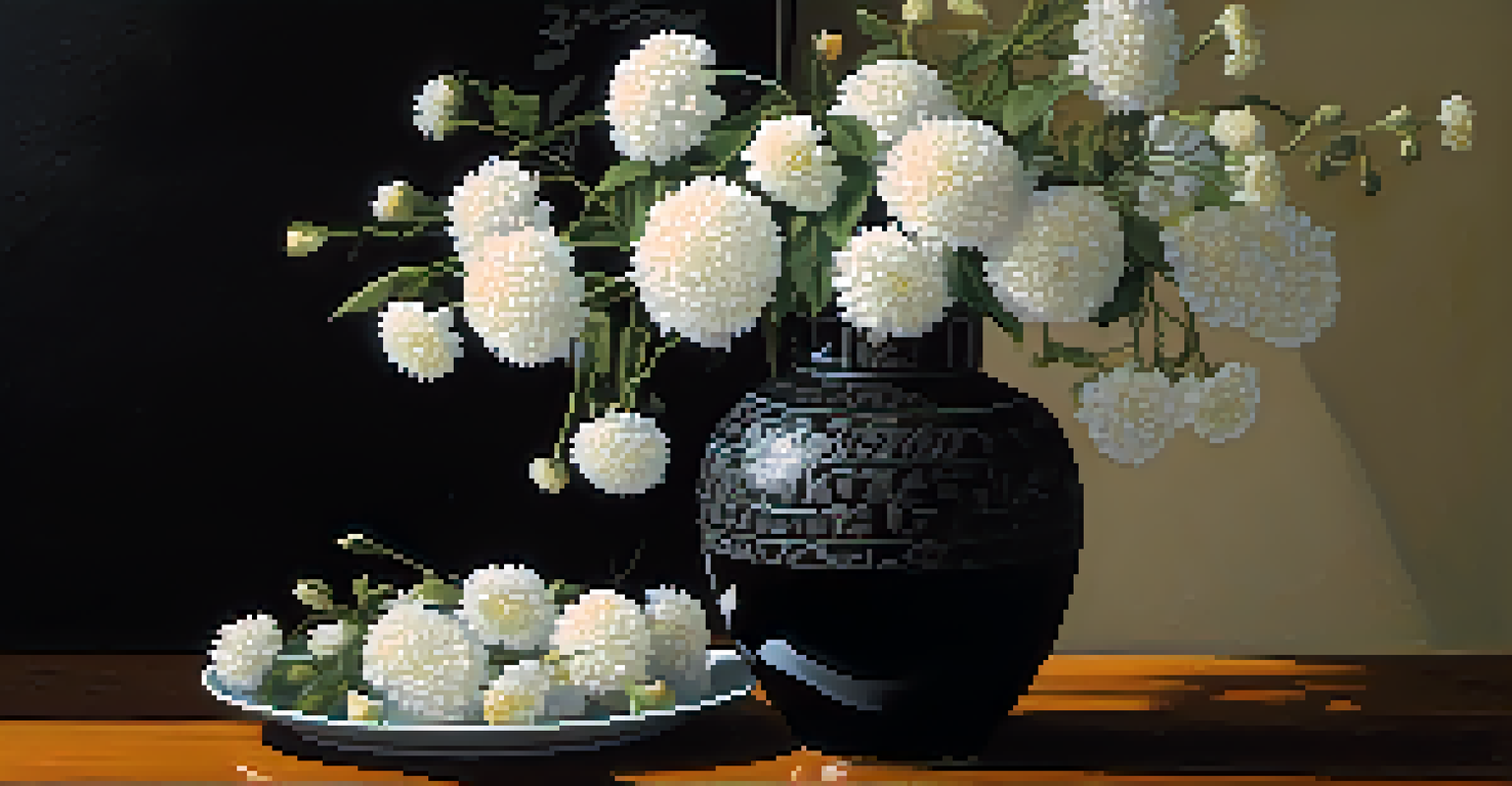The Power of Black: Depth and Mystery in Artistic Works

The Symbolism of Black in Art: More Than Just a Color
Black is often viewed as a color of mourning or sorrow, but its symbolism runs much deeper. In the realm of art, black can convey power, elegance, and even rebellion. Artists frequently use black to evoke a range of emotions and themes, making it a versatile choice across various mediums.
Black is a color of power and elegance, a color that embodies the mystery of art.
Take the iconic painting 'The Night Watch' by Rembrandt, where deep blacks create a sense of drama and movement. The contrast between light and dark not only highlights the figures but also enhances the narrative within the artwork. This interplay serves as a reminder that black can amplify the emotional impact of a piece.
Thus, the choice of black is not merely aesthetic; it’s a deliberate decision that can shape the viewer's experience. By understanding its symbolism, we can appreciate the depth that black brings to artistic creations.
The Emotional Impact of Black: Evoking Feelings and Thoughts
Art has the unique ability to evoke emotions, and black plays a crucial role in this process. It can create a sense of mystery, inviting viewers to ponder and reflect. For instance, the stark black backgrounds in many works by artist Ad Reinhardt push the viewer to focus on the subtleties of form and space.

Moreover, black can evoke feelings of solitude or introspection. Think about the profound stillness in a black-and-white photograph; the absence of color can intensify the subject’s emotions and create a contemplative mood. This emotional depth is what makes black a powerful tool for artists.
Black's Versatility in Art
Black is a powerful color in art that conveys a range of emotions, themes, and cultural significance.
In essence, black is not just about absence; it's about the presence of complexity. By engaging with the emotional weight of black, audiences can uncover layers of meaning in artistic works.
Historical Context: Black's Role in Art Movements
Throughout history, the use of black has evolved alongside major art movements. In the Baroque period, artists like Caravaggio utilized deep shadows to enhance drama and realism. This technique, known as chiaroscuro, played a pivotal role in transforming how light and shadow were perceived in art.
In the world of art, black is not just a color; it is the canvas upon which emotions are painted.
Similarly, in the 20th century, artists from the Abstract Expressionist movement employed black to convey raw emotion and spontaneity. Think of artists like Franz Kline, whose bold black strokes create a sense of urgency and energy. These movements illustrate how black not only adapts but also thrives in various contexts.
Understanding these historical contexts helps us appreciate the enduring relevance of black in art. It serves as a bridge between different eras and styles, showcasing its timeless appeal.
Black in Modern Art: A Tool for Expression
In contemporary art, black continues to serve as a powerful means of expression. Artists like Kara Walker use black silhouettes to explore themes of race, identity, and history. The stark contrast of black against white not only emphasizes the figures but also sparks important conversations about societal issues.
Moreover, modern abstract artists often incorporate black to provide depth and structure to their works. The use of black can ground chaotic colors, creating a balance that draws the viewer's eye. This versatility makes black an essential component in the toolkit of today's artists.
Historical Evolution of Black
The use of black has transformed through various art movements, showcasing its adaptability and enduring relevance.
As we see in modern art, black is more than ever a vehicle for dialogue and exploration. Its ability to provoke thought ensures its continued relevance in the ever-evolving art landscape.
Cultural Interpretations of Black in Art
The significance of black can vary dramatically across different cultures and contexts. In some traditions, black symbolizes fertility and life, while in others, it may represent death or mourning. This cultural diversity enriches our understanding of black's role in art.
For example, in African art, black often signifies strength and resilience, reflecting the culture's deep connection with its heritage. Artists draw inspiration from these meanings, infusing their works with powerful cultural narratives that resonate with their audiences.
By exploring these cultural interpretations, we gain insight into how black transcends simple aesthetics. It becomes a canvas for storytelling, bridging gaps between artists and viewers from diverse backgrounds.
Black and Light: The Dance of Contrast in Art
The interplay between black and light is a fundamental aspect of many artistic works. This contrast can create dramatic tension, highlight focal points, and guide the viewer's eye throughout the piece. Artists often use black as a counterpoint to vibrant colors, allowing those colors to pop and resonate more powerfully.
Consider how Vincent van Gogh employed dark tones in his night scenes to enhance the brilliance of stars and moonlight. The depth of black serves to elevate the luminosity of the lighter hues, creating a dynamic visual experience. This dance between darkness and light is what often captivates viewers.
Cultural Interpretations of Black
Black's meaning varies across cultures, enriching its role in art as a narrative tool that connects diverse audiences.
In essence, black is not just a backdrop; it’s an active participant in the composition. This relationship underscores the importance of contrast in art, allowing both elements to shine in their own right.
Conclusion: Embracing the Power of Black in Artistic Expression
The power of black in art is undeniable. It serves as a tool for emotional expression, cultural commentary, and visual contrast. By embracing the depth and mystery of black, artists can convey complex narratives that resonate with audiences on multiple levels.
As we've explored, black is more than just a color; it’s a multifaceted symbol that has evolved across time and cultures. Whether in classical paintings or modern installations, its presence invites us to look deeper and engage more fully with the artwork.

In conclusion, the next time you encounter a work that prominently features black, take a moment to reflect on its significance. You may find that it opens up new avenues of understanding and appreciation, revealing the profound power that black holds in the world of art.